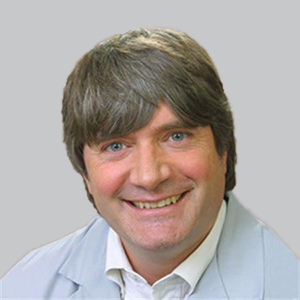Article
Stem Cell Transplantation More Effective Than DMTs in Relapsing MS
Author(s):
Nonmyeloablative hematopoietic stem cell transplantation showed less disease progression in relapsing multiple sclerosis patients after 1 year compared to a number of FDA-approved disease-modifying therapies.
Richard K. Burt, MD, the chief of the Division of Immunotherapy at the Northwestern University Feinberg School of Medicine

Richard K. Burt, MD
The use of nonmyeloablative hematopoietic stem cell transplantation (HSCT) for patients with relapsing multiple sclerosis (MS) was associated with a longer time to disease progression compared to available disease-modifying therapies (DMTs), according to new research.1
Ultimately, the randomized clinical trial showed that 3 of the 55 patients treated with HSCT had disease progression at 1 year based on the Expanded Disability Status Scale (EDSS) scores. The HSCT group experienced a 1.02-point reduction in EDSS score, compared to a 0.67-point increase in the DMT group (P <.001), in which 34 of 55 patients showed disease progression.
Led by Richard K. Burt, MD, the chief of the Division of Immunotherapy at the Northwestern University Feinberg School of Medicine, the investigators randomized 110 patients 1:1 to receive either HSCT or an FDA-approved DMT for at least 1 year of treatment, after which those in the DMT group who experienced disability could cross over to receive HSCT.
The DMTs used to treat patients included: natalizumab (n = 1), dimethyl fumarate (n = 14), fingolimod (n = 14), glatiramer acetate (n = 9), interferon beta-1a (n = 7), mitoxantrone (n = 6), and teriflunomide (n = 1). In addition to DMT, 38 patients received methylprednisolone, 2 received rituximab, and 1 patient each received plasmapheresis, intravenous cyclophosphamide, or intravenous immunoglobulins.
“We think what happens in HSCT is that the immune response is exposed to myelin in the absence of the danger signal and as a consequence is rendered harmless (tolerant), unable to do any more damage,” Burt told the National MS Society.2 “What we’re doing is stopping inflammation you need to treat when the disease in its inflammatory stage, which occurs in relapsing-remitting MS.”
For the HSCT group, the median time to disease progression could not be calculated due to the small number of events, with the total proportion of patients with disease progression being 1.92% (95% CI, 0.27 to 12.9) at 1 year and 2 years. At 3 years, the proportion was 5.19% (95% CI, 1.26 to 20.1), and at 4 and 5 years was 9.71% (95% CI, 3.0 to 28.8).
Meanwhile, the median time for the DMT group was 24 months (interquartile range [IQR], 18 to 48; hazard ratio [HR], 0.07; 95% CI, 0.02 to 0.24; P <.001). The proportion of patients in the DMT group with disease progression was 24.5% (95% CI, 14.7 to 39.1) at 1 year, 54.5% (95% CI, 40.7 to 69.4) at 2 years, 62.5% (95% CI, 48.3 to 76.7) at 3 years, 71.2% (95% CI, 56.8 to 84.2) at 4 years, and 75.3% (95% CI, 60.4 to 87.8) at 5 years.
Mean EDSS scores improved from a baseline score of 3.38 to 2.36 after 1 year in the HSCT group, while the DMT group experienced a decrease from a baseline score of 3.31 to 3.98, for a between-group difference in EDSS from baseline to year 1 of —1.7 points (95% CI, –2.03 to –1.29; P <.001).
“We don’t think this treatment will be very helpful for people with progressive forms (primary or secondary) of MS,” Burt said. “However, there are other forms of stem cell therapy, therapies designed to promote nervous system repair that hold great promise for treatment of all forms of [the] disease, including progressive MS.”
Secondary end points included EDSS score, Neurologic Rating Scale (NRS) score, MRI T2-weighted lesion volume, timed 25-foot walk test (T25WT), 9-hole peg test (9HPT), Paced Auditory Serial Addition Test (PASAT), and the short-form 36 quality of life score.
Notably, there was a significant improvement in EDSS scores, NRS scores, and T2-weighted lesion volume percentages in the 31 patients who crossed over from the DMT group to receive HCST, suggesting that current definitions of progression for RMS may not accurately assess irreversible disease progression for all patients, according to Burt and colleagues. At 6 months and 1 year after randomization, EDSS, NRS, and MRI T2-weighted lesion volume all significantly improved following HSCT compared with the DMT group (P < .001 for all).
In an accompanying editorial, Harold Atkins, MD, noted that one of the trials greatest limitations was the lack of access to treatment with alemtuzumab, and oral cladribine, and ocrelizumab, as they were not commercially available during the study period. "Given that the study began in 2005, when the number of commercially available DMTs was limited, almost a third of patients in the DMT group were treated with a second first-line agent (glatiramer acetate or beta interferon). Currently, patients in whom treatment with a first-line DMT fails would likely be switched to more effective DMTs," he wrote.3
Atkins noted that a post hoc analysis of the 19 patients (40%) in the DMT group who received natalizumab, a second-line agent, showed that a high proportion experienced progression and relapses and lost their no-evidence-of-disease-activity status—an outcome similar to the overall DMT cohort and inferior to the HSCT group. "The inclusion of patients who were less than optimally treated in the DMT group needs to be considered when interpreting the results of this study," he remarked.
REFERENCES
1. Muraro PA, Pasquini M, Atkins HL, et al. Long-term Outcomes After Autologous Hematopoietic Stem Cell Transplantation for Multiple Sclerosis. JAMA Neurology. 2017;74(4):459-469. doi:10.1001/jamaneurol.2016.5867
2. National MS Society. Hematopoietic Stem Cell Transplantation: An Interview with Dr. Richard Burt. MS Connection Blog. Published August 27, 2014. msconnection.org/Blog/August-2014/Hematopoietic-Stem-Cell-Transplantation-An-Intervi. Accessed January 25, 2019.
3. Atkins H, Stem Cell Transplantation to Treat Multiple Sclerosis . JAMA. 2019;321(2):153-155.
doi
:10.1001/jama.2018.20777.




